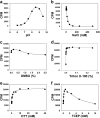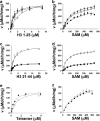Trimethylation of histone H3 lysine 36 by human methyltransferase PRDM9 protein
- PMID: 24634223
- PMCID: PMC4002121
- DOI: 10.1074/jbc.M113.523183
Trimethylation of histone H3 lysine 36 by human methyltransferase PRDM9 protein
Abstract
PRDM9 (PR domain-containing protein 9) is a meiosis-specific protein that trimethylates H3K4 and controls the activation of recombination hot spots. It is an essential enzyme in the progression of early meiotic prophase. Disruption of the PRDM9 gene results in sterility in mice. In human, several PRDM9 SNPs have been implicated in sterility as well. Here we report on kinetic studies of H3K4 methylation by PRDM9 in vitro indicating that PRDM9 is a highly active histone methyltransferase catalyzing mono-, di-, and trimethylation of the H3K4 mark. Screening for other potential histone marks, we identified H3K36 as a second histone residue that could also be mono-, di-, and trimethylated by PRDM9 as efficiently as H3K4. Overexpression of PRDM9 in HEK293 cells also resulted in a significant increase in trimethylated H3K36 and H3K4 further confirming our in vitro observations. Our findings indicate that PRDM9 may play critical roles through H3K36 trimethylation in cells.
Keywords: Cancer; Enzyme Inhibitors; Enzyme Kinetics; Epigenetics; Histone Methylation; Methyltransferase.
Figures









References
-
- Kouzarides T. (2007) Chromatin modifications and their function. Cell 128, 693–705 - PubMed
-
- Murray K. (1964) The occurrence of ϵ-N-methyl lysine in histones. Biochemistry 3, 10–15 - PubMed
-
- Byvoet P., Shepherd G. R., Hardin J. M., Noland B. J. (1972) The distribution and turnover of labeled methyl groups in histone fractions of cultured mammalian cells. Arch. Biochem. Biophys. 148, 558–567 - PubMed
-
- Paik W. K., Kim S. (1967) ϵ-N-Dimethyllysine in histones. Biochem. Biophys. Res. Commun. 27, 479–483
-
- Hempel K., Lange H. W., Birkofer L. (1968) ϵ-N-Trimethyllysine, a new amino acid in histones. Naturwissenschaften 55, 37. - PubMed
Publication types
MeSH terms
Substances
Grants and funding
LinkOut - more resources
Full Text Sources
Other Literature Sources
Chemical Information
Molecular Biology Databases
Research Materials

